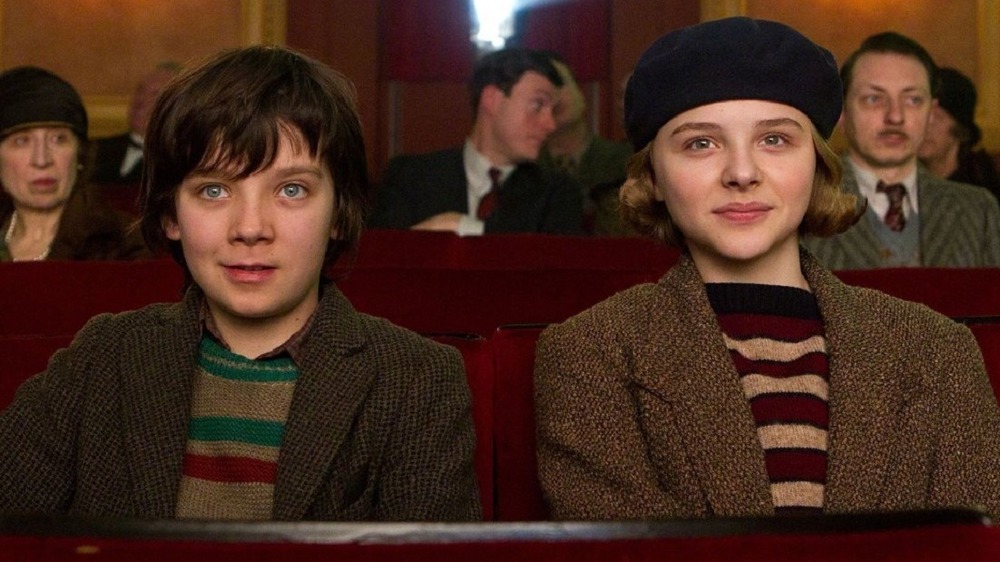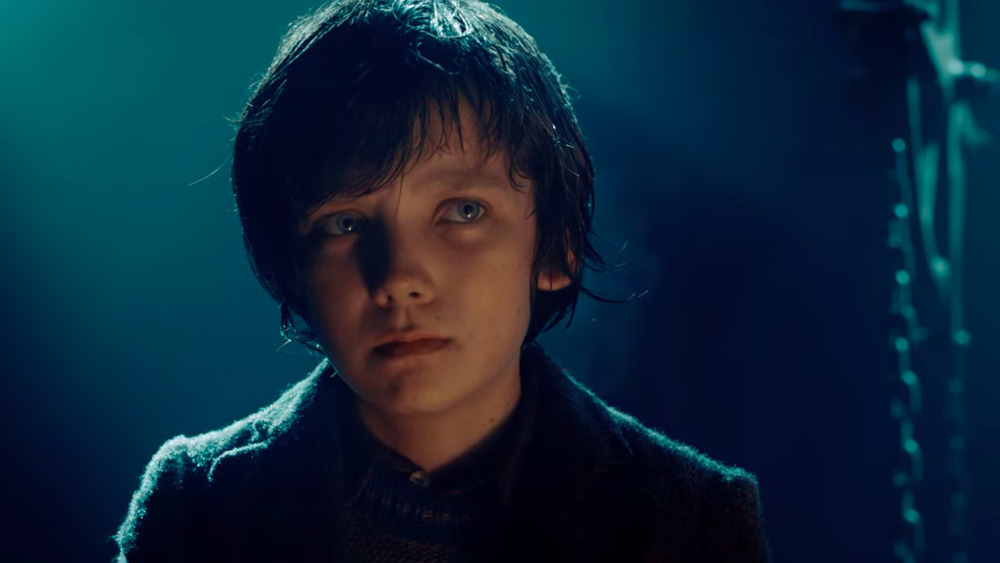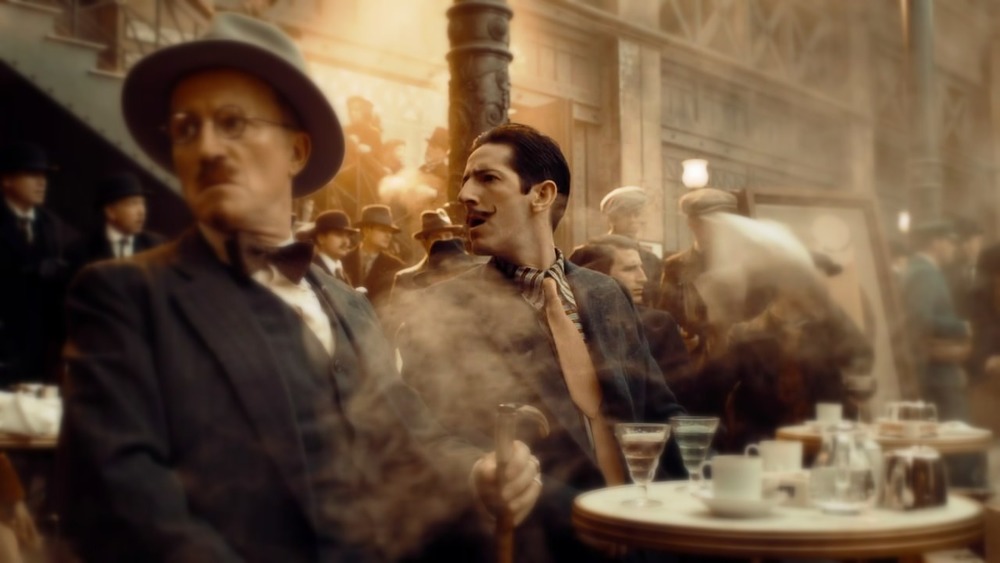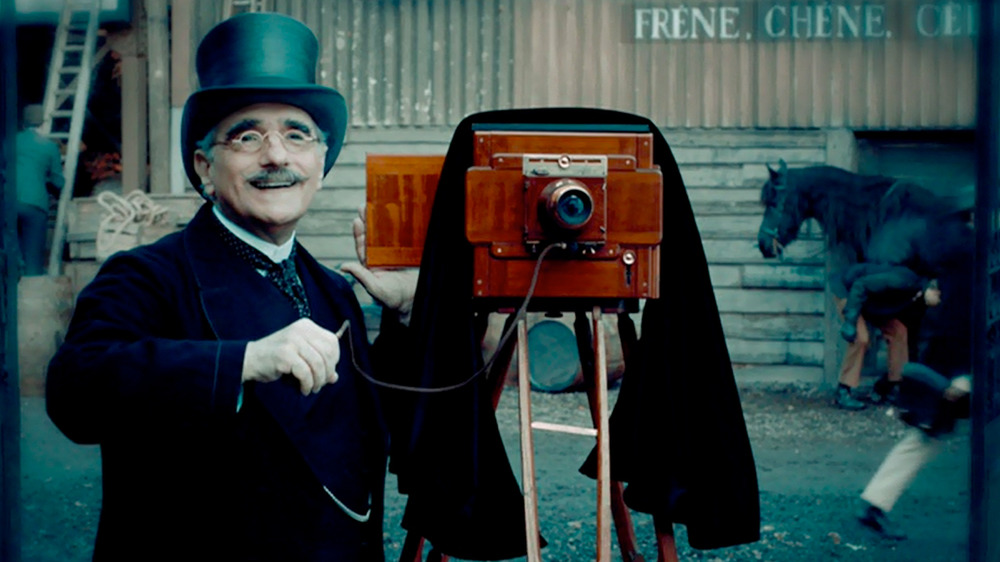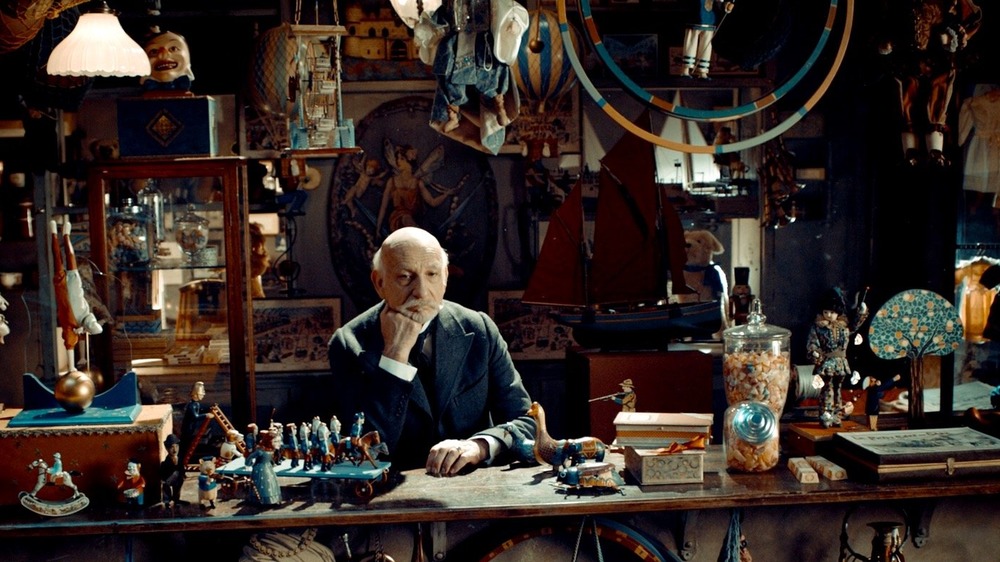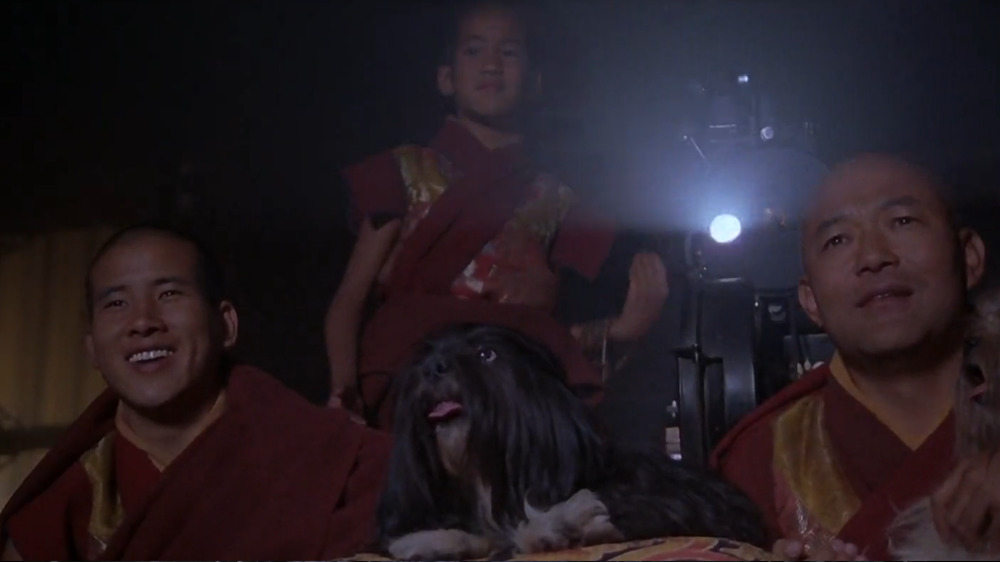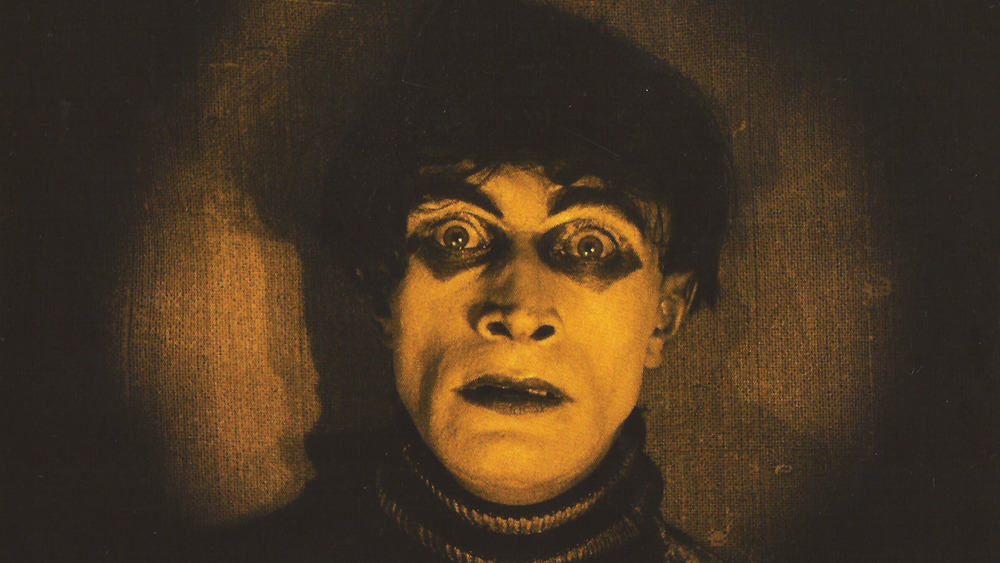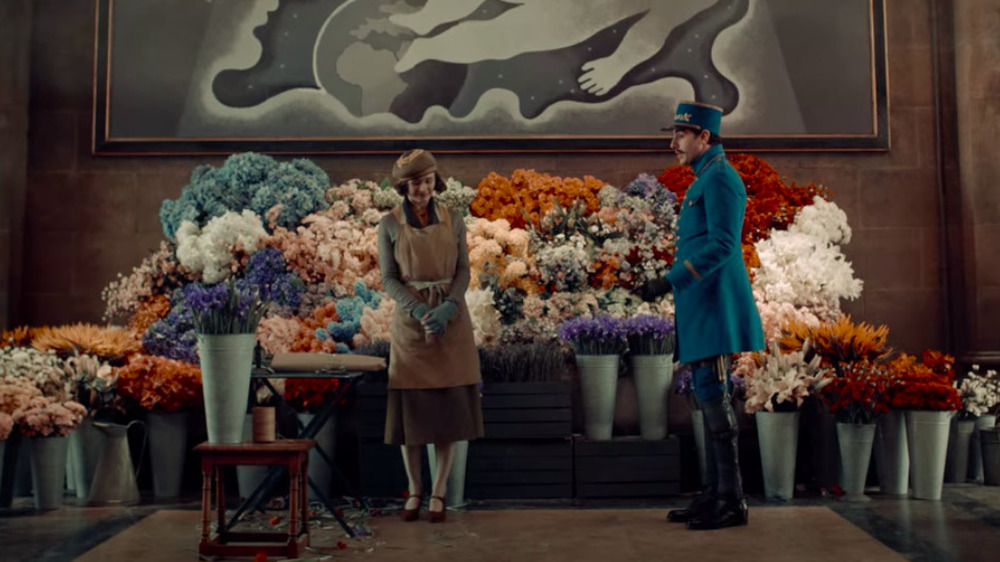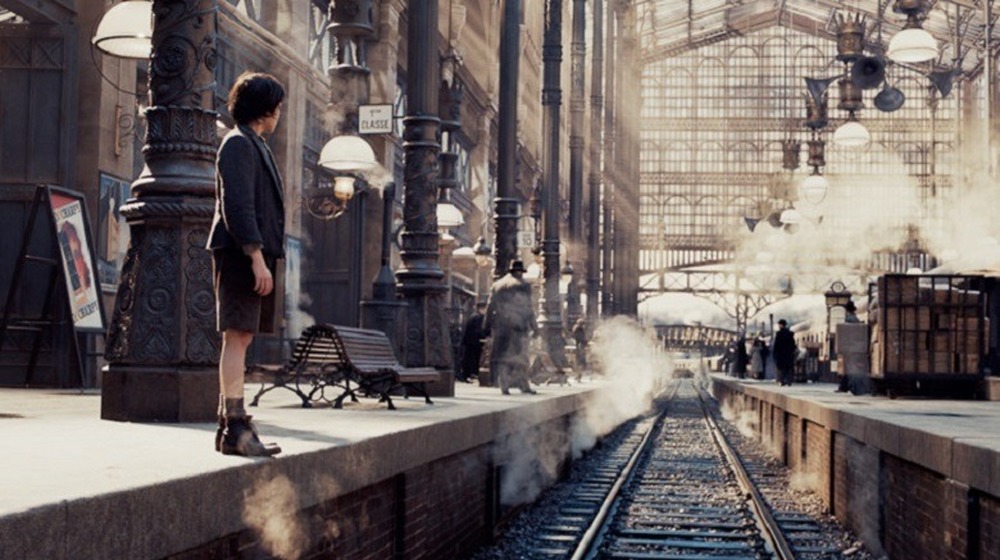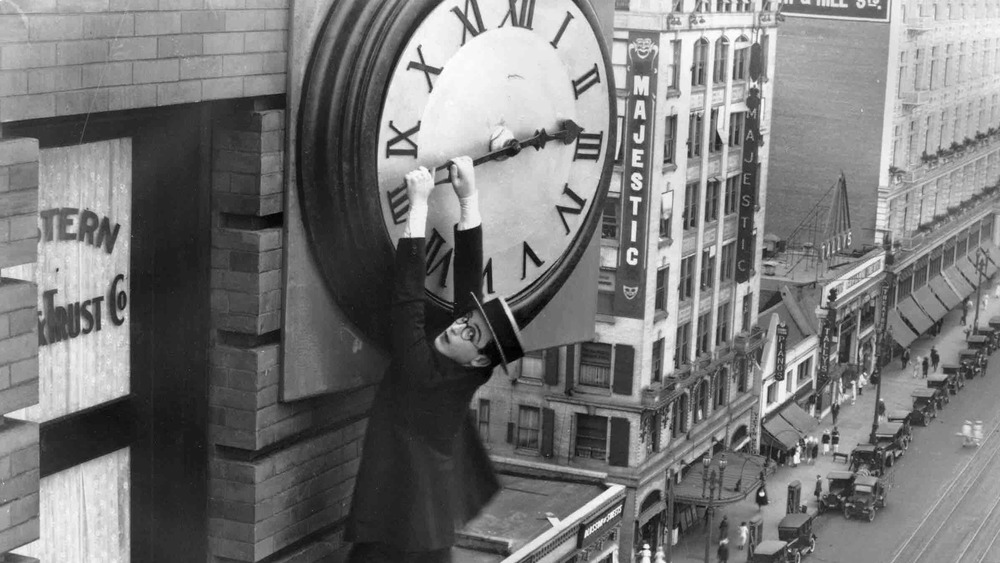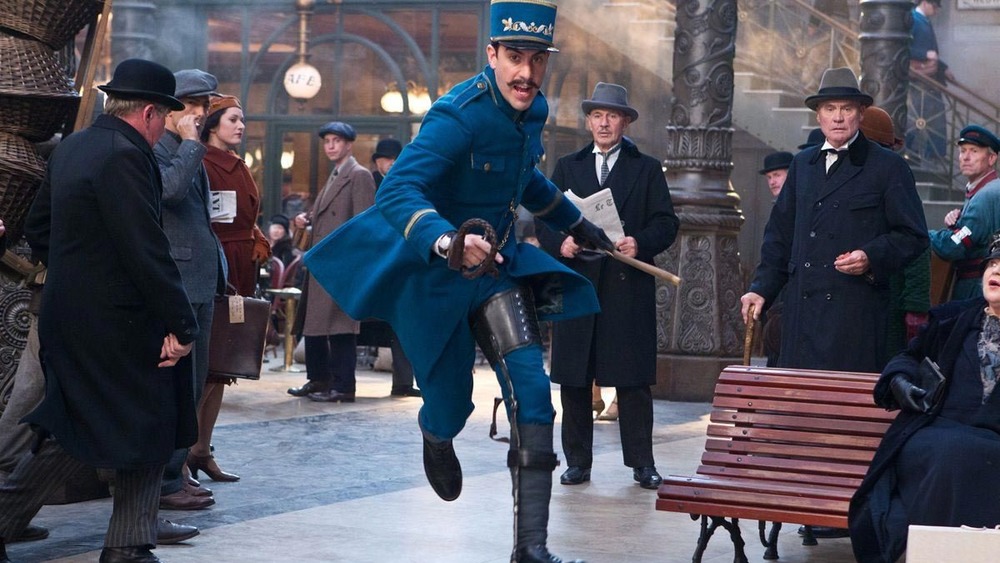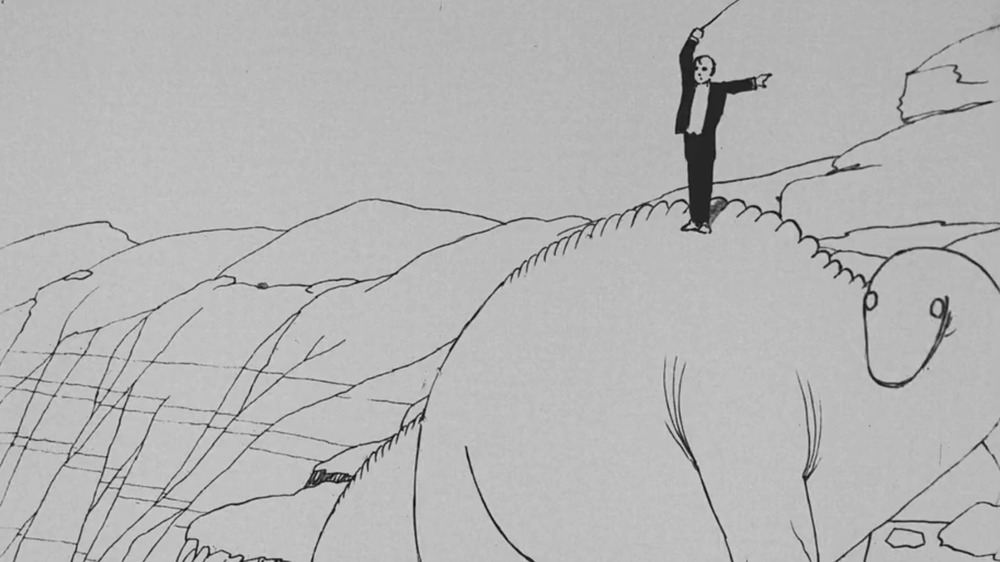Things Only Adults Notice In Hugo
Martin Scorsese is legendary for his tough-minded, brutally violent, very un-kid-friendly gangster epics, from 1973's Mean Streets all the way up to 2019's The Irishman. And yet, one of his very best movies is about as far from that formula as you can get — a sumptuously beautiful historical fantasy for children that goes down as soothingly as a hot cup of cocoa.
Based on the illustrated novel by Brian Selznick, Hugo tells a timeless story that could've come from its 1930s setting, if not earlier, of the titular orphan boy (Asa Butterfield) living in the clocks of a Paris train station, the Gare d'Orsay. He's obsessed with repairing a broken clockwork man, his last connection to his dead father, and his quest leads him to Georges (Ben Kingsley), a bitter old toy salesman, revealing the secrets of both their pasts.
It's not the kind of thing most viewers would expect from the legendary director, but Scorsese's trademark emotional depth and obsessive love for cinematic history is all over Hugo. As a result, there are plenty of secrets lurking behind the kid-pleasing fairytale narrative and its 3D spectacle for adults to explore. Let's take a look.
Hugo uses machinery to draw parallels between film and memory
If there's anything to take away from Hugo, it's that movies truly can be magic, which the film proves both in its loving tribute to the silent era and in practice with the nonstop inventiveness of Robert Richardson's 3D cinematography and its stunning recreation of a lost time and place.
Hugo develops this idea in subtler ways, too. Films can be living memories, whether they're our own home movies or documents of the distant past like the silent movies that appear throughout Hugo. Scorsese subtly draws this connection when we see Hugo thinking about his late father (Jude Law). As he's remembering, Hugo is framed by one of the clock's enormous gears as it casts flickering light on him and ticks away on the soundtrack. That sound should be familiar to anyone who remembers the days of analog film projectors, as it closely recreates the sound of the filmstrip running through the machine. The intermittent light passing through the gear's spokes should conjure up those same memories, recalling the flickering projector light that gave movies their nickname, "flicks."
When the memories are over, we return to the present, and the ticking sound even slows down the way a film reel does as it reaches the end. This little touch cements the idea of the flashback as a kind of movie within the movie.
Look out for cameos in the café
From the aftermath of World War I through the '30s, Paris attracted an impressive collection of incredible artists. And since then, these writers, painters, and poets have popped up occasionally in some prestigious films. For example, a few months before Hugo debuted, Midnight in Paris sent Owen Wilson back in time to hobnob with the likes of Pablo Picasso, Ernest Hemingway, and Gertrude Stein.
Hugo is much more concerned with its own characters' adventures than the luminaries they share the city with, but if you look closely, you'll see some of them hanging around the margins. For example, a café in the Gare d'Orsay features live music by a thin young man with an even thinner mustache. That's supposed to be Django Reinhardt, a Belgian guitarist who discovered jazz right around the time Hugo takes place and popularized guitar as a jazz instrument.
When Hugo interrupts Reinhardt's performance trying to escape from the Station Inspector (Sacha Baron Cohen), we see a brief reaction from two other Parisian celebrities. One of them, with his unmistakable curly mustache, is the great Spanish surrealist painter Salvador Dalí. A founder of the postwar Surrealist movement and still its most famous artist, Dalí created hundreds of paintings, drawings, sculptures, and unclassifiable oddities over his half-century career. His tablemate is James Joyce, the Irish author of even more experimental works like Ulysses and Finnegan's Wake, who wrote in a stream-of-consciousness style full of new words and tangled webs of references.
Martin Scorsese makes an appearance in Hugo
One of Scorsese's idols, Alfred Hitchcock, made a point of playing a small role in every movie he ever directed. Scorsese himself doesn't go that far, but he's still a frequent presence in his own films, and Hugo is no exception.
When Hugo discovers Papa Georges' lost film, A Trip to the Moon, the old man finally shares the past he's kept secret for so long. He'd once been a famous magician before discovering the Lumière brothers' new invention of the movie camera and deciding he'd go into business making his own movies. We next see him in front of the enormous greenhouse he uses as his studio, getting his photo taken to commemorate the occasion.
Behind that camera (just like in real life) is Martin Scorsese. Later, we see Georges making one of his fantastical movies, and if you listen closely, you can hear Scorsese in the background commenting on his performance.
Film fans will guess Papa Georges' identity before Hugo does
We've described Hugo as a fantasy, but a whole lot of it happened in reality. There really was a filmmaker named George Méliès, and he really did go bankrupt and spend his twilight years working in a train station toy shop (even though it was in Montparnasse and not the more photogenic Gare d'Orsay) before his fans tracked him down. And all the clips we see from his films are real.
Hugo rightly describes Méliès as the first filmmaker to realize movies could be used to not just record reality but to create works of fantasy. This means that he's a staple of film education, and most people who've taken a class or even cracked open a book on the medium's history will be familiar with his work, especially the iconic image of a rocket landing in the Man in the Moon's eye from A Trip to the Moon. This scene has received homages in everything from Futurama to Smashing Pumpkins' classic video for "Tonight, Tonight."
When Hugo recalls his father telling him about seeing the film, wheels may already be turning in attentive viewers' minds about Georges' identity. But it all really comes together when Hugo finally gets the automaton to work thanks to a key from Georges' goddaughter, Isabelle (Chloe Grace Moretz), and watches the machine draw that classic image from Méliès' film. Hugo's careful not to tip its hand too early, not revealing Georges' last name until that scene, but savvy viewers may be well ahead of it by that point.
It's not Scorsese's first tribute to Méliès
As strange as Hugo might seem as a Scorsese project, it's clear the directors' passion for film history drew him to the project. He's particularly fascinated with the work of the real-life Méliès and his contemporaries, so much so that they've popped up in Scorsese's work long before Hugo.
In 1997, Scorsese directed Kundun, based on the life story of Tibet's spiritual leader, the Dalai Lama, from his selection for the role as a child to his exile following Mao Zedong's annexation of Tibet. In one scene, the Dalai Lama enjoys some of the treasures that foreign dignitaries have brought him from around the world, including a film projector that he uses to watch a silent fantasy film by one of Méliès' imitators, Gaston Velle.
Scorsese made a more direct tribute to Méliès the year before Hugo's premiere in the documentary Picasso and Braque Go to the Movies. Scorsese is one of many filmmakers, painters, and historians interviewed in a film that traces the cross-pollination between Cubist art and the movies. Scorsese's main contribution is a tribute to Méliès, who he recalls seeing on TV before falling in love with his work in film school. Scorsese uses Méliès' films as a launching point to discuss the relationship between movies and dreams, just like he would in Hugo when the hero's father says that A Trip to the Moon is "like dreaming when you're awake."
The library montage is jam-packed with classics
After discovering Papa Georges' connection to the automaton, Hugo and Isabelle run down to the library to see what they can find about his mysterious past. The librarian recommends The Invention of Dreams by the (fictional) scholar René Tabard (Michael Stuhlbarg). They find some of the answers they're looking for along with a wealth of knowledge about the magic of the early movies, represented in a montage so full of classic moments that film fans won't want to blink.
Some highlights include one of the first films ever made, Employees Leaving the Lumière Factory, and other early experiments by the Lumiére brothers and Thomas Edison. Hugo and Isabelle read about the Lumiere film Arrival of a Train at La Ciotat and how the audience flinched when the train came at them, foreshadowing a later scene where the film inspires both Papa Georges to make his own movies and Hugo's nightmare where a train nearly runs him over.
The great silent comedians Buster Keaton and Charlie Chaplin appear in scenes from their own respective masterpieces, The General and The Kid. So does the Sleepwalker from the pioneering German horror film The Cabinet of Dr. Caligari and the spectacular Babylon set from the multimillion-dollar epic Intolerance. Scorsese even includes some sneaky references to his own movies. An Edison film of a boxing match recalls Raging Bull, his biography of boxer Jake La Motta.
The Station Inspector gets Freudian with his flirting
Every story needs a villain, and Hugo's is Sacha Baron Cohen as the Station Inspector, a clownish boogeyman who chases Hugo across the train station to take him away to the orphanage. But Scorsese has spent his career finding the humanity in gangsters and mass murderers, and as he says in the documentary Shoot the Moon: The Making of Hugo, he wanted to do the same for the Station Inspector.
So, we get to see what he's like when he's not terrorizing children, including his awkward flirtation with a flower seller played by Emily Mortimer. It gets especially awkward when he takes station regular Madame Emile's (Frances de la Tour) advice to "be intrepid" and starts a conversation with her. He attempts to make small talk about her wares, and when she says a bouquet of posies come from Gourdon, the Station Inspector begins rambling. "Splendid country, that," he says. "Robust. The weather ... the cows and such ... mooing ... perfectly formed udders."
Kids may not think anything of it, but adults watching the Station Inspector gesturing around his chest will have a good idea what's really on his mind. It's doubtful the country in Gourdon's the only thing he thinks is robust, and from there, it's even easier to guess what reminded him of udders.
Hugo's nightmare really happened
In the film, Hugo has a series of surreal nightmares. In the first one, he finds the key to the automaton lying on the train tracks, and even though he sees it's safe to run down and grab it, a train suddenly comes speeding into the station. The engineers frantically try to stop the locomotive, crashing through the cement floor of the station and all the way through the outside walls. It's a shocking moment, even more so if you were lucky enough to see it in 3D. But that kind of thing only happens in dreams, right?
Well, it really did happen across town from Hugo's station in 1895, and the scene of the train hanging out the window is copied directly from a photo taken at the scene. At the Gare Montparnasse, the engineer of an express train from the village of Granville to Paris was running late and poured on the speed to make up for lost time. Whether he made it is a moot point, since the train was going so fast that he was either too distracted or unable to brake before the train hit the end of the tracks, and it continued speeding a hundred feet across the station and through the wall, killing one woman and injuring five passengers. The train stayed hanging there for four days, where Levy and Sons took the picture.
Hugo's signature image comes from a comedy classic
Hugo is full of unforgettable images, but one that stuck most with viewers (and that Paramount emphasized in its marketing) shows the young engineer hanging from the hands of the Gare d'Orsay's enormous clock.
Even before Scorsese got ahold of it, the hero hanging from a clock face was already one of the defining images of the silent era. In Safety Last!, Harold Lloyd, one of the funniest stars of all time, plays a clerk at a big-city department store who's convinced his friend, Bill, to climb to the top as a publicity stunt. Unfortunately, Harold ends up taking Bill's place for the first floor, which soon turns into the first two floors ...and eventually the whole way up.
In the most famous scene, Bill opens a window to check on Harold, not realizing Harold's standing on it , which almost sends him plummeting all the way to the ground. Harold just makes it by grabbing onto a nearby clock. Scorsese's not the type to steal without credit, though. In an earlier scene in Hugo, Hugo and Isabelle sneak into the movies just in time to catch Lloyd's famous stunt on the big screen, and no doubt, Hugo was inspired by Safety Last the same way his creators were.
In a story about the power of the movies, it's a perfect moment. Movies can't just give us the tools to realize our dreams — they might just save a life.
Hugo has a lot to say about the trauma of war
Hugo provides all the magic and adventure the little ones could want, but it also has some much heavier subjects on its mind, the kind that most kids hopefully don't have to deal with.
Part of the reason so many people landed in Paris in the '30s is they were a so-called "Lost Generation" left adrift after World War I. That's certainly the case for the Station Inspector, who's so painfully self-conscious about his war injury and the noisy leg brace it requires him to wear that in two separate scenes, he bails out of his conversations with the flower seller when it starts squeaking. He's only able to overcome his discomfort when she connects with him over their shared loss, telling him her brother died in the war. Papa Georges never served, but the war scarred him in his own way, changing the world so completely that it no longer has any place for him.
Hugo wasn't even born until after the war had ended, but he still has his own traumas that connect him to the other characters. The loss of his home and family are literally connected to Georges' losses through the automaton, a remnant of Hugo's lost father and Georges' lost career. And while not as much is made of it, there's a suggestion that he shares some trauma with the Station Inspector, too, who tells him, "It's straight to the orphanage with you! You'll learn a thing or two there. I certainly did."
Papa Georges' showcase pays tribute to another pioneering film magician
Fortunately, our story has a happy ending. Thanks to Hugo, the filmmaker who believes he's been forgotten is reunited with the people who remember him but believed he was dead. They invite Georges to introduce an exhibition of some of the 200 films they've rescued from obscurity. He delivers a heartfelt tribute to the power of the magic of the movies and to the boy who reconnected him with them. Then he performs one more magic trick, seemingly leaping into the screen, seamlessly transforming into his younger self.
Another filmmaking magician of Méliès' generation played a similar trick in his most famous film. Winsor McCay created Little Nemo in Slumberland, one of the earliest and still most beloved comic strips, for the New York Herald all the way back in 1905. But even pioneering a whole medium wasn't exciting enough for him, so he decided to try another, adapting Little Nemo into one of the very first animated cartoons, inventing techniques that are still used today.
Audiences at the time were willing to believe that photos could move but not drawings, and they insisted it was somehow a fake. McCay responded with How a Mosquito Operates, and when audiences still didn't believe that (thinking the mosquito was being operated by wires), he animated a creature no one could ever photograph. McCay performed live with Gertie the Dinosaur as Gertie's "trainer," using sleight of hand to interact with the film. And for a grand finale, he seemed to leap through the screen and onto Gertie's back, just like Georges does in Hugo.
Even then, some people initially thought the dinosaur was made of papier-mache, but they were eventually convinced by McCay's animation.
